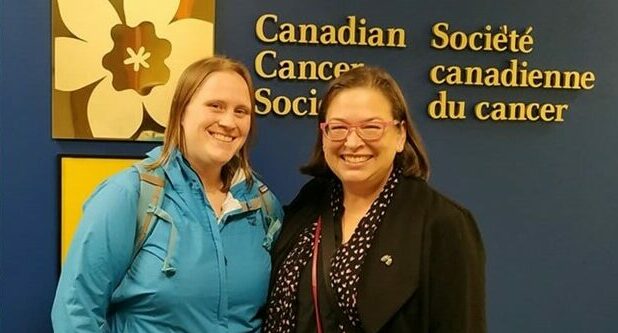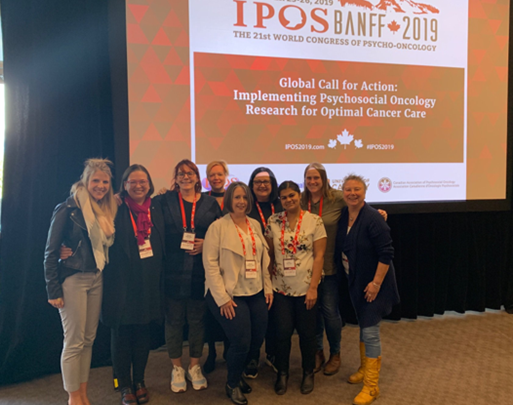
Dr. Victoria Forster, PhD is a cancer survivor and research scientist who understands the key roles that patient partners can play in successful research programs.
She is an accomplished science communicator and a 2017 TEDGlobal Fellow who has written articles for The Times, The Guardian, Forbes Health, and recently contributed a piece entitled “What cancer survivors can teach cancer researchers” to Nature Reviews Cancer. She completed her postdoctoral fellowship in Dr. Uri Taboori’s lab at the Hospital for Sick Children (SickKids) in May and has since been appointed the Lead of Patient and Community Engagement at Women’s College Hospital in Toronto.
We asked Dr. Forster for her perspectives on how trainees can effectively engage with patients and their advocates and what they can expect in return.
How does cancer research benefit from collaboration with patient partners?
In my opinion, if you want to make sure that your research is impactful, engaging with patient partners is vital. For a research team to have direct contact with people that have direct experience of a health condition is beneficial on so many levels.
Non-clinical scientists, in particular, frequently use patient data and samples, but sometimes have very limited contact with the actual people their work seeks to help. I think this is a shame as patient advocates are often keen to meet and communicate with scientists about their work. Patients also ask the best questions, which can be unexpected and especially for young scientists, it’s brilliant for them to be challenged and motivated to think about their work and the greater impact of it. I’ve come up with just as many ideas for my research projects by interacting with patients as I have going to scientific conferences.
Involving patient partners can also ensure that research is innovative and frankly, wanted. As an example, I recently saw a conversation on Twitter led by patient advocates who were living with metastatic breast cancer. They had seen a recent paper which involved mouse work looking at how prophylactic cranial radiotherapy could reduce the impact of brain metastases. Cranial radiotherapy of course comes with numerous side effects and impact on quality of life and frankly the advocates were pretty annoyed about the paper. They didn’t want more damaging cranial radiotherapy to extend their lifespan by a small amount at the expense of quality of life, they wanted different approaches and solutions. That’s a lot of research funding and use of animal models for something which patients might well just reject if it ever got into practice. This is just one example, but perhaps if these scientists had consulted patients, they might not have done that project, or perhaps they would have approached their work in a different way.
What can patient partners bring to the early stages of cancer research?
I think people at all stages of cancer research are aware of why they are doing research and of course, ultimately that is to help people. However, especially the more with the fundamental, basic science research questions, it can be hard for researchers to see why they should involve patients at these early stages, when any findings might be several years away from having clinical impact. But I’m a strong advocate for involving patients at every stage of the research process. If you’re doing a very early-stage modelling project, say in drosophila or yeast and you can’t explain to a patient how you hope your work will eventually benefit others like them, why are you doing it? It can really help researchers organize their ideas and think about the bigger picture and implications of their work. Just because your work comprises the first rung of a very long ladder to clinical benefit, does not mean that it’s not vitally important and patients do want to hear about it. In fact, brand new, innovative approaches and concepts are often particularly well received by patient advocates.
What strategies have you found to be successful in engaging patient partners? Have you identified any recurrent barriers to engagement?
This is a big and varied topic, but I think one of the main barriers to involving patients in research is often anxiety regarding how to effectively communicate. This can be an issue across the board with several stages of cancer research, but basic/fundamental research often contains the most jargon and although some researchers are excellent at translating their work for non-scientific audiences, many are not and are intimidated by the idea of doing so. Often, this is just uncertainty about whether they can form a good working relationship with patients. This can sometimes include reasonable concern about causing harm and upset, especially in situations where you might be talking to a patient who perhaps, is living with terminal cancer, or also perhaps a person who lost their child, or spouse to cancer.
Navigating these interactions is not always easy and it does require some planning and effort. More rarely, researchers conclude “patients could not possibly understand something this technical,” which is arrogant and frankly, just indicates that they neither have or are willing to gain the skills required to facilitate effective relationships with patients. It is true that very technical, jargon-heavy projects are probably the most challenging to effectively communicate to patients and the public and do require effort, but sometimes researchers are not willing to put in this effort. If you are in a room with patient partners and you’ve just presented your research to them and they have nothing to say, the chances are you didn’t communicate it well enough, or you didn’t facilitate an environment in which they felt comfortable talking to you. Luckily nowadays there are training courses for science communication and especially in Toronto, trained science communication and outreach staff at many institutions which can often help with this. But the bottom line is that creating productive and equitable relationships with patient partners requires time and effort.

If you’re a trainee and you want to hear what people who are affected by the disease you’re studying have to say, and where they want the research to go in the future, where do you start?
Honestly, I would start online. Even for the rarest cancers, there are patients talking about their experiences online – whether it be via blogs, social media or advocacy organizations. Twitter, I have found to be a great place to connect with patients and other people with lived experience – and of course what patients say on there is public – and they are aware of this. Facebook can be a little more tricky as there are a ton of patient communities and groups on there but as a researcher you really have to consider whether such groups are for you or not. We have to respect that patients may have different expectations of privacy on Facebook and may be happy sharing their experiences only with others like them. If in any doubt, ask a group moderator before you post.
You could also check out the numerous broad- and cancer-specific organizations that exist to ask whether they could link you up with patients. Many of these organizations work directly with or indeed are run by patients who are already invested in advocacy and improving things for others like them.
However you try to connect with patients, make sure to identify yourself, who you are and be clear about what you are looking for – for example, if you are looking for patients to advise on a project, be explicit about that. Also be mindful of giving people enough information to decide whether they are interested pretty early on. Directing them to a website where they have to read for 10mins to figure out whether they are eligible or not is placing the burden of time and effort on patients – and we should try to minimize this as much as possible. Many patients are keen to get involved and already spend a lot of time advocating for improvements in care and research, but we should value their time and therefore be as clear as possible about what we want from the start.
Are there other organizations that have established protocols to facilitate these interactions in a thoughtful and sensitive way?
Yes, one notable example is the Strategy for Patient Oriented Research (SPOR) from the CIHR which is worth a read as a general guide. However, we have to remember that ‘patients’ even within the broad scope of a particular health condition – are incredibly varied and heterogeneous, so no matter which guidelines you follow, to facilitate a truly productive and equitable researcher and patient team, bespoke approaches will also be needed. I think many organizations, patients and researchers are somewhat learning as they go along – but there is more of an effort now to provide guidelines and sometimes even training in how to effectively facilitate these relationships. McMaster University, for example, does a 10-week course on “Family Engagement in Research” which is fantastic and many of the lectures and discussions are very relevant for patient engagement in research.
To learn more about how to effectively incorporate patient partners in your research activities, please check out Dr. Forster’s blog and follow her on Twitter @vickyyyf.
Posted on:
